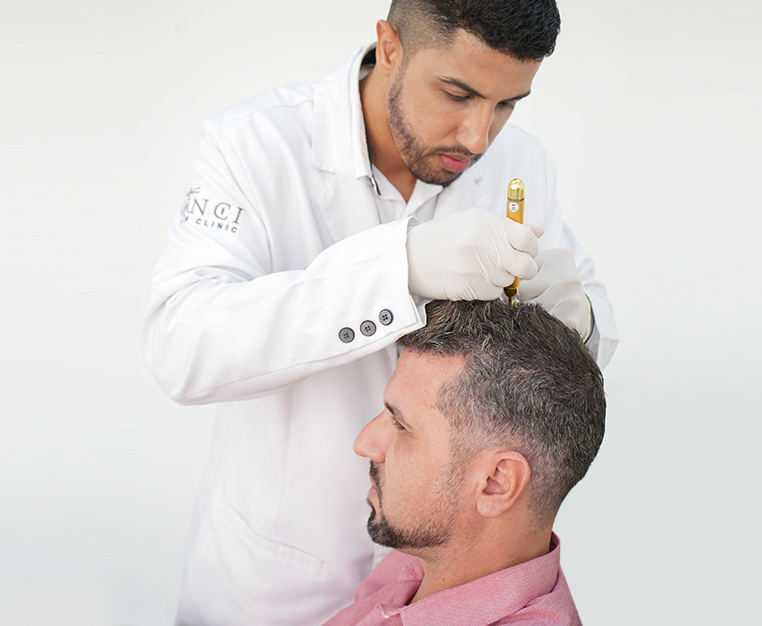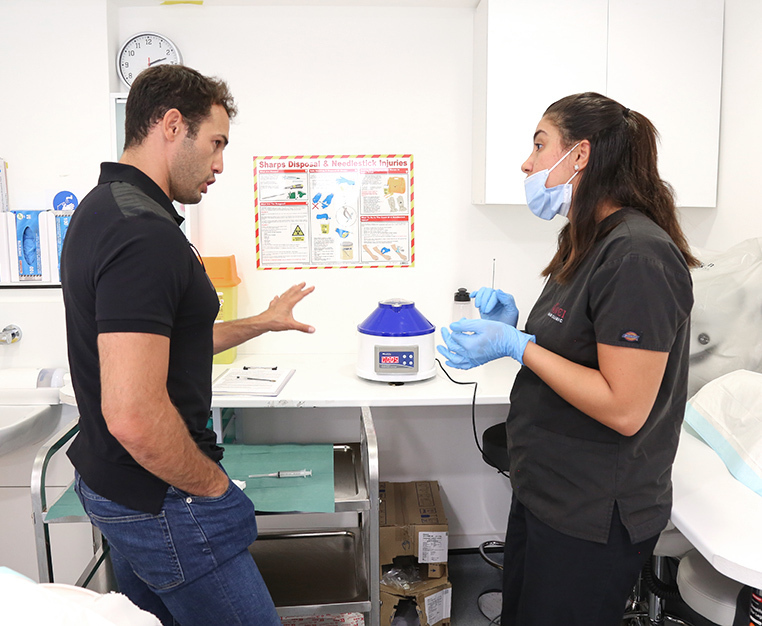Have you been noticing more hair in your brush lately?
It’s natural to feel concerned when strands start falling out, but not all hair loss signals a problem. Shedding is a normal part of the hair growth cycle, and losing a small amount each day is completely expected. That said, excessive hair loss can be a sign of something more serious. Recognising the difference can help you take action early and protect your hair.
In this article, we’ll explain how much hair loss is considered normal, what may be causing increased shedding, and which treatments can help you regain healthy growth. Whether you’re facing seasonal changes, hormonal fluctuations, or stress-related shedding, there are effective solutions to support your scalp and hair.
The Hair Growth Cycle: A Natural Process
Hair grows in a repeating cycle with three main phases. The anagen phase, or growth phase, can last between two to six years and accounts for up to 90% of the hairs on your head at any given time. Next comes the catagen phase, a brief transition period lasting two to three weeks when growth slows, and the follicle begins to shrink. Finally, the telogen phase is when the hair rests for one to three months before naturally shedding and making way for new growth.
What Counts as Normal Hair Loss?
Generally, losing up to 100 strands a day is nothing to worry about. You might notice more hair than usual on days when you shampoo or brush more vigorously, or if you’re using a clarifying hair loss shampoo that dislodges hairs ready to fall. Genetics, scalp condition, diet, and even seasonal changes can influence how much you shed on any given day.
“In my experience, it’s completely normal to lose some hair daily — even up to 100 strands — but what often concerns patients is a visible change in density,” explains Dr Salvar Björnsson, founder and CEO of Vinci Hair Clinic. “The key is whether that loss is consistent, progressive, or accompanied by other signs like thinning or patchiness.”
Still, if you’re seeing an unusual increase in hair on your pillow, shower drain, or hairbrush — especially alongside visible thinning at the crown or a widening part — it could suggest more than routine hair loss. In many cases, this points to a type of hair thinning known as androgenetic alopecia, or pattern hair loss. Caused by a genetic sensitivity to the hormone DHT (dihydrotestosterone), this condition gradually shrinks hair follicles over time and can begin as early as your 20s.
When to Worry: Signs of Abnormal Hair Loss
While everyone sheds hair to some extent, certain signs may indicate that it’s time to seek professional advice. These include persistent shedding over several weeks, visible thinning or bald patches, and changes to your scalp such as itchiness, redness, or flaking. In some cases, patchy hair loss in circular areas may point to autoimmune conditions like alopecia areata.
The sooner these signs are addressed, the more effective your treatment options are likely to be.
Common Causes of Hair Loss
Hair loss can result from a variety of physical, hormonal, and lifestyle factors. Here are some of the most common:
Hormonal fluctuations can significantly impact hair growth. In women, perimenopause often triggers thinning due to declining oestrogen levels, which shorten the growth phase of the hair cycle. For men, hereditary pattern baldness is typically linked to DHT, which gradually causes hair follicles to shrink and produce thinner, shorter hairs.
Stress is another key factor. Intense emotional or physical strain can push large numbers of follicles into the telogen phase, leading to shedding that becomes noticeable a few months after the stressful event.
Nutritional deficiencies can also play a role. Low levels of iron, zinc, vitamin D, or biotin may contribute to weak or slow-growing hair. Women with low ferritin levels (a marker of iron storage) are particularly susceptible.
Medications and supplements can sometimes cause or accelerate hair loss. For example, there is some limited evidence that creatine may raise DHT levels, which could increase hair shedding in those with a genetic predisposition.
Underlying health conditions or medical treatments, including thyroid issues, autoimmune disorders, or chemotherapy, can lead to sudden or severe hair loss. In such cases, it’s crucial to speak with a doctor to address the root cause.
What You Can Do to Stop Hair Loss
Tackling hair loss successfully often requires a multi-step strategy, combining lifestyle changes with professional support.
Start by using a targeted shampoo formulated for hair loss. Look for products that strengthen follicles and promote scalp health, like those that clear away DHT buildup and stimulate blood flow to the hair roots. Nioxin, for instance, is a commonly recommended brand used two to three times weekly alongside a gentle conditioner.
Natural remedies may also offer benefits. Rosemary oil has become increasingly popular as a botanical treatment to support hair growth. When diluted with a carrier oil and massaged regularly into the scalp, it can help increase circulation and extend the hair growth phase.
Managing stress is another essential component. Elevated cortisol levels can disrupt the hair cycle, so techniques like meditation, mindfulness, regular exercise, and quality sleep can make a noticeable difference in your hair’s condition.
For more advanced or persistent cases, clinical treatments may be the next step. Platelet-rich plasma (PRP) therapy uses growth factors from your own blood to stimulate inactive follicles. Low-level laser therapy, often in the form of red light caps or combs, can help improve density and follicle activity. And for individuals experiencing significant hair loss, surgical options like Follicular Unit Extraction (FUE) offer permanent, natural-looking results.
Learn more about these options at Vinci Hair Clinic’s treatments page.
Take Control of Your Hair Health
Hair loss can feel overwhelming, but understanding what’s normal and taking early action can make a big difference. With the right combination of scalp care, nutritional support, and professional treatments, it’s possible to slow shedding and encourage healthy regrowth.
If you’re ready to explore options like rosemary oil, hair loss shampoos, or more advanced clinical treatments like PRP or FUE, don’t wait. A qualified specialist at Vinci Hair Clinic can guide you toward the most effective solution for your unique situation.
Frequently Asked Questions About Hair Loss
How much hair loss is considered normal?
Shedding between 50 and 100 hairs daily is part of the natural hair cycle. Consistent loss beyond that range may signal an underlying issue.
Can stress really cause hair loss?
Yes, prolonged or intense stress can disrupt the hair cycle and trigger a condition called telogen effluvium, leading to temporary hair loss.
Does creatine cause hair loss?
There is limited research suggesting that creatine may increase DHT levels, which could contribute to hair thinning in genetically predisposed individuals. However, more studies are needed.
Will rosemary oil help regrow hair?
Some research suggests that rosemary oil can stimulate circulation and support hair growth, with effects comparable to 2% minoxidil in certain studies. Results can vary.
When should I see a doctor about hair loss?
If you’re experiencing sudden or excessive shedding, bald spots, or any changes to the scalp, it’s best to consult a specialist as soon as possible. Early treatment tends to yield better results.


